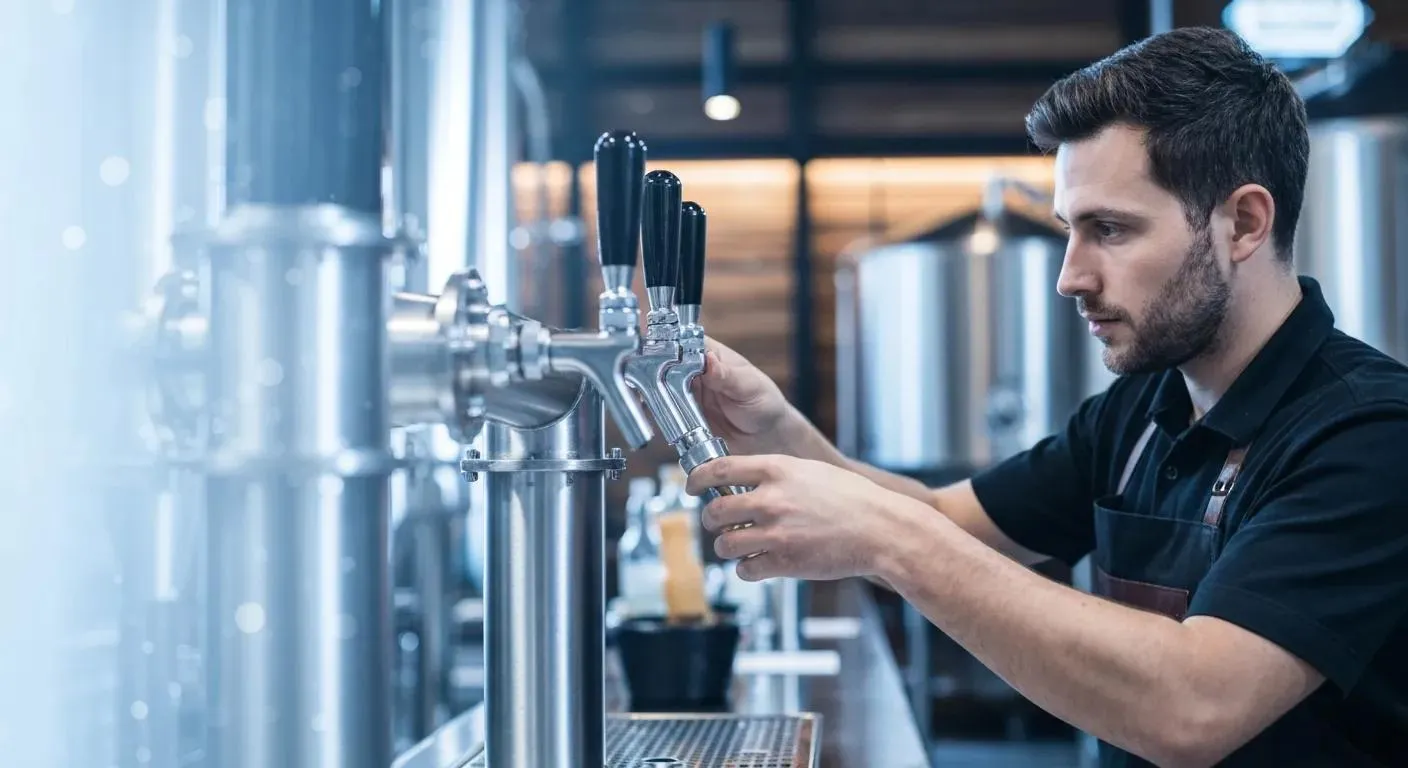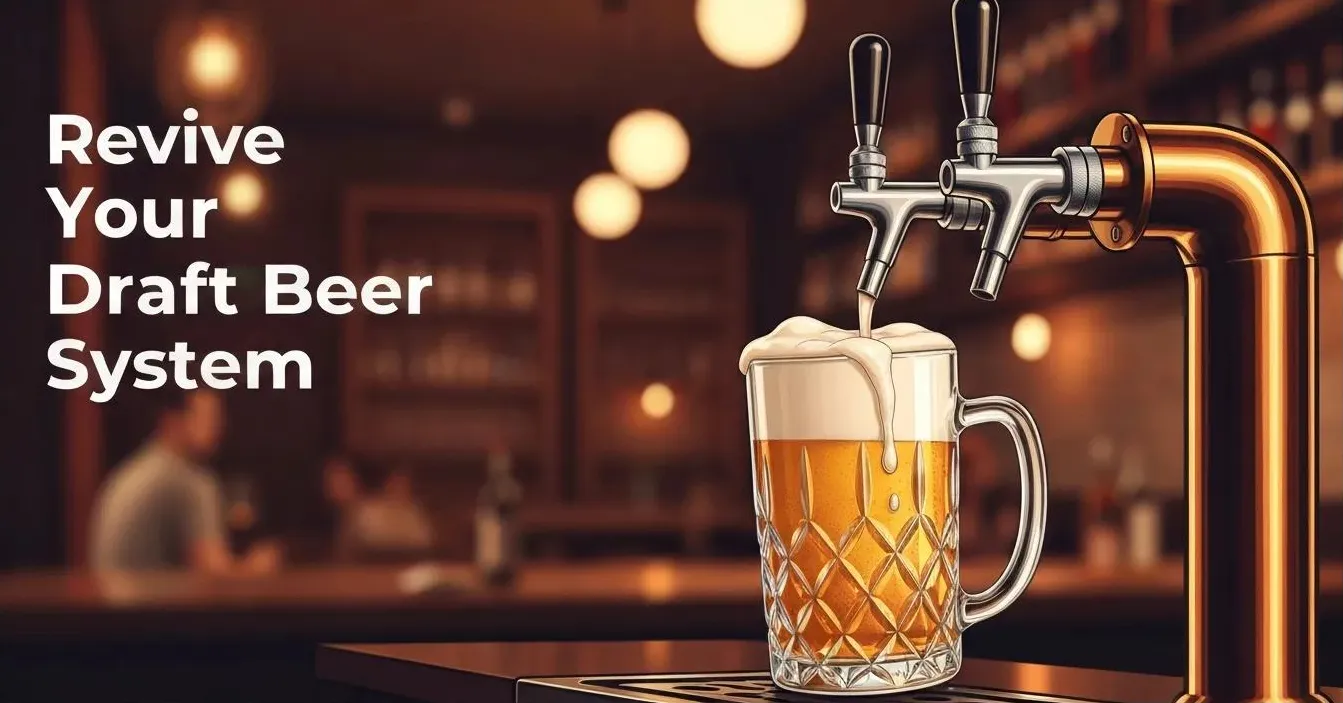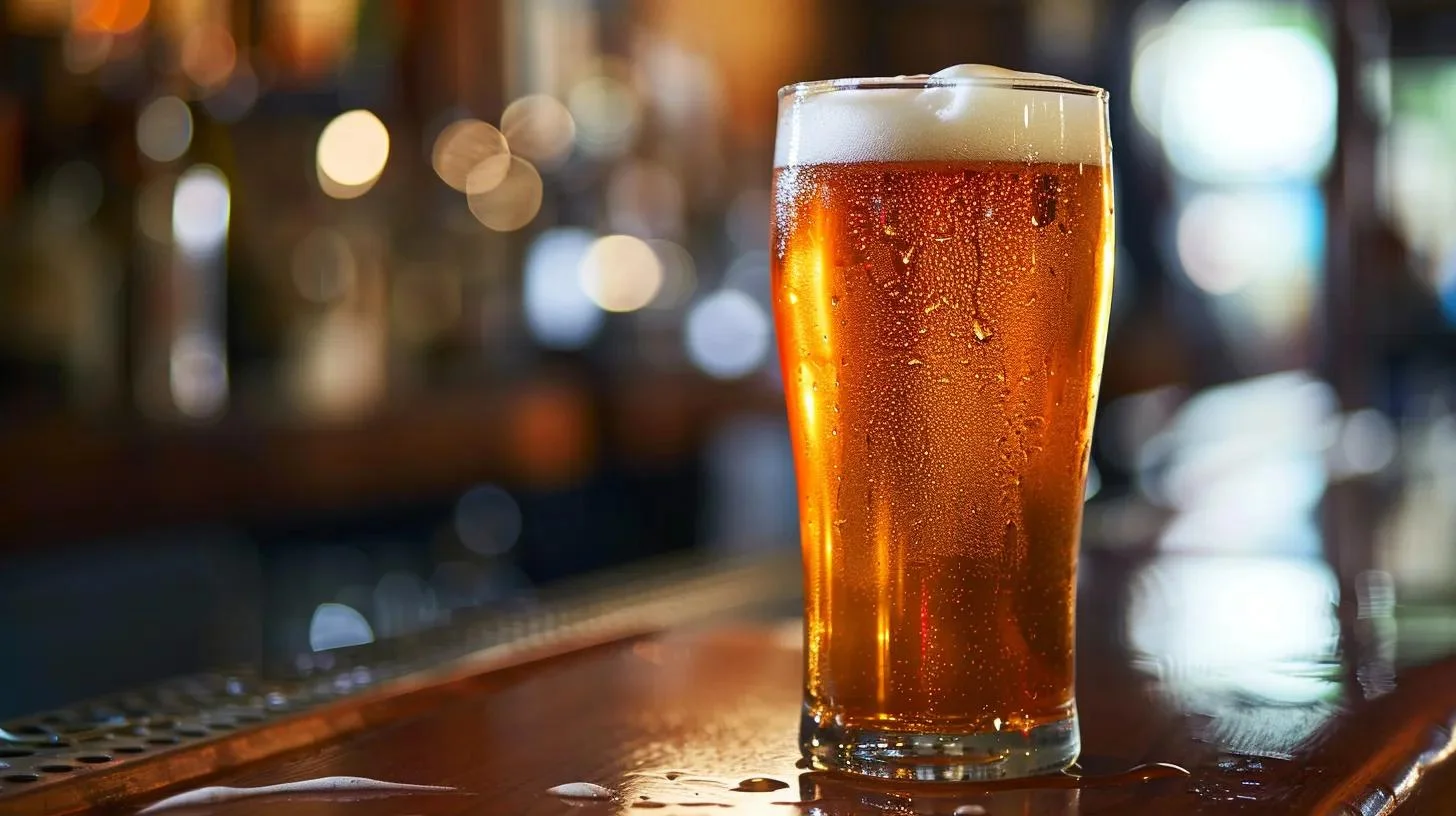Beer Tap Installation: The Ultimate Guide for Retailers Installing a Beer System

A beer tap system can elevate your beer-drinking experience by providing you with freshly poured draft beer. Installing a beer tap system may seem like a daunting task, but with proper planning and understanding of the necessary components, it can be a manageable and rewarding project. By breaking the process down into simple steps. We can show you what you'll need to accomplish this.
Before beginning the installation process for the beer tap itself, it is crucial to understand the different types of beer tap systems and their corresponding components. This includes familiarizing yourself with draft towers, faucets, beer lines, fittings, couplers, and regulators, among other critical equipment. A well-designed and properly installed beer tap system will not only enhance the taste and presentation of your favorite brews but also improve the overall efficiency and profitability of your bar. So let's get started.
Key Takeaways
- A beer tap system installation involves understanding various components of the system.
- Proper planning and design are crucial for a successful and efficient beer tap setup.
- Regular maintenance and troubleshooting are necessary to ensure optimal performance and preserve the quality of your draft beer system.
Understanding The Basics
Beer Tap System Components
A beer tap system is made up of several key components that work together to dispense draft beer. The main parts of a beer tap system include the keg, regulator, CO2 tank, keg coupler, beer line, and beer tower. The CO2 tank supplies the necessary pressure to force the beer out of the keg and through the lines. The regulator is responsible for controlling the pressure within the system, ensuring a consistent flow of beer. The keg coupler attaches to the keg, providing a connection between the keg and the beer line. The beer tower connects the faucet to the beer line, allowing the liquid to flow through. Finally, the faucet is the point of dispense, where the beer is poured into a glass.

Types of Beer Tap Systems
There are various types of beer tap systems available, including kegerators, manual beer taps, and self-serve beer taps. Kegerators are refrigerator-like devices that typically hold a single keg at a time, making them suitable for home use or smaller venues. Manual beer taps rely on a user pulling a lever or turning a tap handle to dispense the beer, while self-serve beer taps allow customers to pour their own drinks using an automated dispensing system. Each type of beer tap system has its pros and cons, depending on factors like cost, convenience, and the desired dispensing experience.
Direct Draw VS Long Draw Systems
Beer tap systems can be further divided into two main categories: direct draw and long draw systems. Direct draw systems are simpler, with the keg placed in close proximity to the point of dispense. These systems typically use a kegerator or a custom-built draft fridge or beer cooler and are ideal for smaller spaces or lower volume usage.

Long draw systems, on the other hand, are designed for larger venues where the kegs need to be stored farther away from the dispensing points. In these systems, cooled glycol lines run alongside the beer lines to maintain a consistent temperature, ensuring the beer remains cold and fresh as it travels from the keg to the faucet. Long draw systems may require more extensive installation and maintenance, but they offer the flexibility needed for larger operations with limited space and a wider variety of beer options on tap.

Properly understanding and assembling a beer tap installation requires the right combination of equipment, as well as knowledge of the different types of beer tap systems and their components. By being aware of these essentials, you can ensure a successful beer tap installation that delivers a perfect pour every time.
Planning and Design
Choosing the Right Space
When planning to install a beer tap system, selecting the right space is crucial for both aesthetics and functionality. Consider the bar space. First, make sure there is enough space for the beer tower, tap handle, and beer lines, as these components will require room for installation and operation.
For bars and restaurants with commercial beer tap systems, a tap wall can be an effective way to showcase a variety of beers on tap. When designing your beer tap tower or wall mounted beer tap, ensure there is sufficient space to accommodate the desired number of taps as well as any tap handle customizations.
In addition to appearance, proper planning and design can greatly affect the performance of your beer tap system. For instance, well-balanced beer systems result in less foamy pours for bars and restaurants. So when planning, consider the distance between your beer tower and the keg cooler. Lastly, hiring the right draft beer technician is key.
Choose the Right Walk-in Cooler
For commercial beer tap installations, an essential element is to select and properly plan the installation of a walk-in cooler. The ideal walk-in cooler should:
- Be large enough to store all necessary kegs, but small enough to maintain efficiency.
- Have proper insulation to maintain a consistent temperature.
- Be easily accessible for changing out kegs and maintaining beer lines.

In summary, carefully planning the space and design for your beer tap installation is key to achieving optimal performance and aesthetics for commercial applications.
Installation Process
Equipment to Use
When installing a beer tap system, it is essential to have the right equipment on hand. Here is a list of items you will need:
- Drill
- Oetiker clamp/ Pliers
- Cutters
- Walk-In Beer Cooler
- Refrigerator or jockey box
- Draft system components (keg tap, CO2 canister, gas regulator, beer lines, etc.) All Stainless steel.
- Beer tower
- Wall mount beer tower if hanging on a wall
- Glycol chiller for proper temperature control
- Gas Blender or Separator
- Stainless steel fittings
Make sure to choose high-quality equipment for a durable and efficient draft beer system.
Installation Steps
- Select the location: Choose a suitable spot in your establishment for your beer tap system.
- Prepare the bar top: Drilling holes in the countertop will be necessary to install the draft system components. Unless you mount it on a wall. Use a drill to create the required holes, making sure they are precisely measured and spaced. Drill holes for Stainless steel drip tray.
- Install the beer tower: Place the beer tower on the countertop and connect the trunkline to the tower.
- Assemble the draft system: Connect the various components, such as the keg couplers, Primary CO2 Regulators, and secondary regulators using the beer lines. Ensure a secure connection with oetiker clamps.
- Cooling system setup: An essential part of a draft beer system is temperature control. Use a glycol chiller for long draw systems to maintain the beer at the right temperature.
- Test the system: Ensure everything is tightly connected. Check for any leaks in the system using an air compressor before hooking up the beer. Pour a glass of beer and monitor the beer flow to confirm everything is functioning correctly.

By following these steps, you can confidently and efficiently install a draft beer system, making your draft beer dispensing and experience enjoyable.
When it comes to beer tap systems, proper maintenance, and troubleshooting are crucial for ensuring the best quality pours and preventing any issues with your equipment. In this section, we will discuss the importance of cleaning your beer and dispenser tap system and some common troubleshooting tips.
Cleaning Your Beer Tap System
Regular cleaning of your beer tap system is essential to maintain the taste and quality of the beer. Cleaning not only helps to prevent contamination but also ensures the proper functionality of your system. Here are the key components of your beer tap system that require attention:
- Beer lines: Dirty beer lines can cause off-flavors and lead to foamy beer. It's recommended to clean the lines every two weeks using a proper cleaning solution. This will remove any buildup and ensure smooth, controlled flow of beer. You can find detailed instructions on beer line cleaning here.
- Faucets and beer tower: Over time, sediment and yeast can accumulate in the faucets and beer tower. This can affect the flow and taste of your beer. To clean these parts, remove and disassemble the beer faucets, then soak them in a cleaning solution before rinsing and reassembling.

- Gaskets: Gaskets play an essential role in sealing various connections in your beer tap system. Ensure that gaskets are in good condition and replace them if they appear worn or damaged.
- Drip trays: Drip trays should be cleaned regularly to prevent the buildup of spilled beer and bacteria. Simply remove the trays, wash them with a mild detergent, and rinse thoroughly.
In addition to cleaning, it is essential to regularly inspect your beer tap system for any potential issues. Some common problems and their solutions are:
- Foamy beer: This can be caused by dirty lines, improper temperature, or issues with the coupler. Check your system for cleanliness, make sure your beer is stored at the recommended temperature (36-38 degrees Fahrenheit), and inspect the coupler for any damage. More information on troubleshooting foamy beer can be found here.
- Poor flow: This can be due to a kinked or pinched beer line, or a clogged faucet. Check your lines for any obstructions, ensure that your CO2 pressure is set according to the brewery's recommendation, and clean the faucet to remove any blockages.
- Leaking connections: Inspect your system for any leaks and tighten connections as needed. Replace any worn gaskets or damaged components to prevent future leaks.
By following these maintenance and troubleshooting tips, you can ensure a perfect pour every time and extend the life of your beer tap system.
Adaptation for Other Beverages
Beer Tap Systems for Other Beverages
Aside from beer, draft systems can be used for a variety of beverages, such as wine, kombucha, and coffee. This provides convenience and a unique experience for consumers. Here are some of the popular alternatives to consider:
Draft Cocktails
Draft cocktails are becoming increasingly popular due to their time-saving benefits and consistent taste. Using a draft system ensures that each serving has the same quality, taste, and presentation. This approach is ideal for venues where speed and efficiency during service are crucial. To create draft cocktails, ingredients are pre-mixed and stored in kegs, allowing for efficient dispensing with a beer tap system.

Wine
Using a draft system for wine is an eco-friendly and efficient alternative to traditional wine bottles. Wine on tap helps reduce waste and spoilage by eliminating the need for corks, bottles, and labels, while also providing a more consistent taste. Additionally, wine stays fresher for a longer time when served through a draft system, as it minimizes exposure to oxygen. Make sure to use a wine-specific draft system to maintain the quality and unique characteristics of the wine.

Coffee
Cold brew and nitro coffee have gained popularity in recent years, and a draft system offers an excellent way to serve them. This method allows for a smoother and creamier texture, as the coffee is infused with nitrogen gas under pressure. The nitrogen interacts with the coffee, giving it a velvety mouthfeel and a cascading effect similar to that of a stout beer. A beer tap system designed for coffee dispensing works best for this application, as it ensures proper pressure and temperature settings.
In conclusion, draft systems are not limited to beer; they can be adapted for a wide range of beverages, providing unique serving experiences and benefits to both businesses and consumers. Whether it's wine, kombucha, or coffee, utilizing a beer tap system can contribute to a more efficient, consistent, and eco-friendly service.
Summary
In summary, this comprehensive guide provides an in-depth look at installing a beer tap system, an essential feature for enhancing the beer-drinking experience in any retail setting. Key points include:
Understanding Beer Tap Components: A clear explanation of the various components of a beer tap system, including kegs, regulators, couplers, beer lines, and beer towers, is crucial. Each plays a vital role in ensuring a smooth and efficient dispensing process.
Types of Beer Tap Systems: The guide differentiates between kegerators, manual beer taps, self-serve systems, and the two main categories of beer tap systems - direct draw and long draw. This knowledge helps in selecting the right system based on the specific needs of a venue.
Planning and Design: Emphasizing the importance of choosing the right space and designing the setup for both functionality and aesthetics, the guide covers essential considerations like space requirements, the layout of tap walls, and the selection of a suitable walk-in cooler.
Installation Process: Detailed steps guide through the installation process, highlighting the necessary equipment and providing a step-by-step approach to setting up the system, from selecting the location to testing the setup.
Maintenance and Troubleshooting: Regular cleaning and maintenance are underscored as vital for preserving the quality of the beer and the longevity of the system. The guide provides practical tips for cleaning and troubleshooting common issues like foamy beer or poor flow.
Adaptation for Other Beverages: The versatility of beer tap systems is showcased, illustrating how they can be adapted for serving a variety of beverages like draft cocktails, wine, and coffee, thus broadening the scope of their application in a retail environment.
Overall, this guide serves as a valuable resource for retailers looking to install and maintain a beer tap system. If you would like to help to put a draft beer dispensing system together please give us a call at Renny's.
Cheers!



